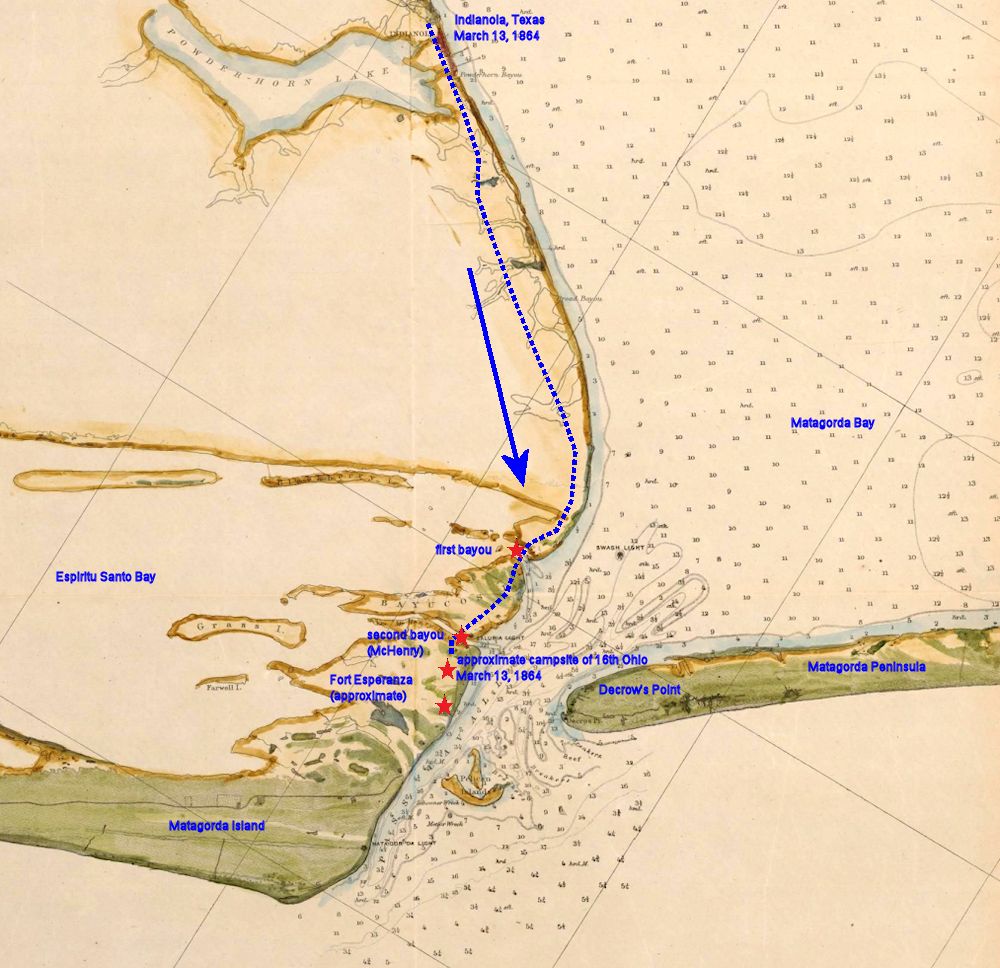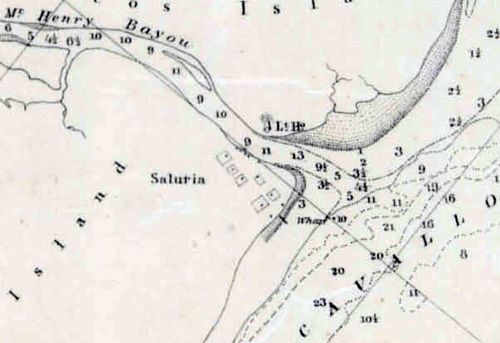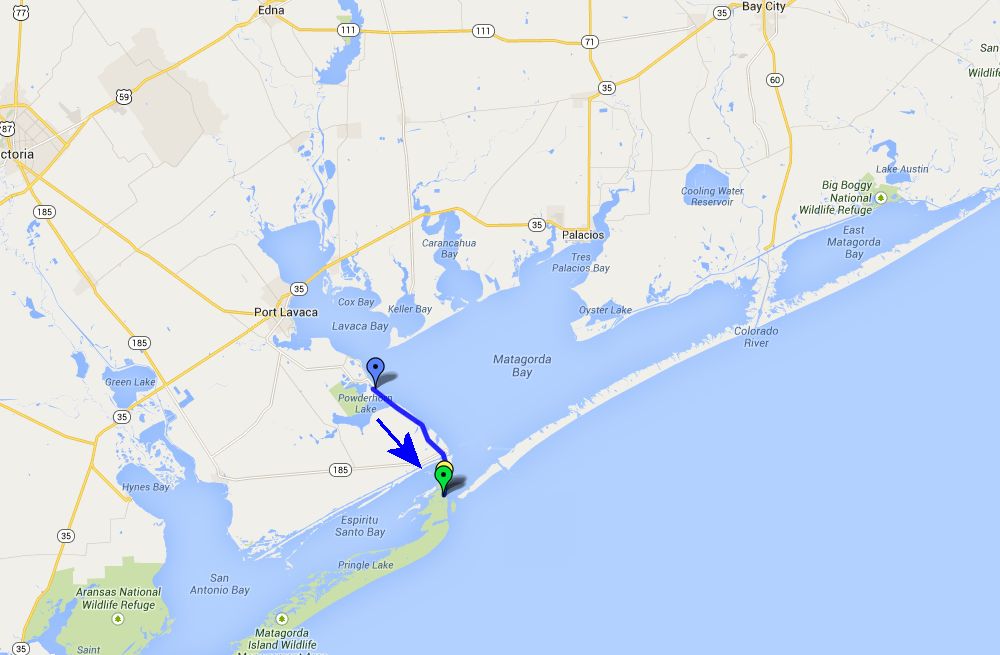| Previous Date | Day By Day Index | 16th OVI Home Page | Next Date |
Where was the regiment on
Sunday, March 13, 1864
The Union troops, including the 16th Ohio, had been ordered to be ready to evacuate Indianola, Texas, on March 9. However, heavy storms cause the process to be greatly slowed. The steamer Planter had been loaded with much of the regiment's baggage but the storms blew the ship aground. It had to be freed by work of the steamer Matamoras and a tug named Percy.
Finally, on March 13, the troops marched from their camp at Indianola to a new camp on Matagorda Island. Most of the Union troops moved a little further south to near Fort Esperanza, but the 16th Ohio stayed back, making their camp near the small village of Saluria.
A most tragic event occurred while the Union troops were moving from Indianola to Matagorda Island. We will use this excerpt from Cpl. Theodore Wolbach's history of the regiment, Camp and Field, to explain what happened in the words of a soldier who was present when it happened:
Our march to the island was by a road that ran close to the bayou. In the after part of the day we made slow progress on account of two bayous that were too wide to pontoon with the limited material we had with us. Sections of the pontoon bridge were built and floated between two cables that extended from shore to shore. It made an excellent ferry for calm weather, but to-day the wind was strong and made it a little dangerous for big loads to cross. When the float was brought up snug against the shore a mule team would be driven on, and enough soldiers to complete the load would follow. The crossing of the first bayou was effected with but one mishap, which resulted from the dipping of the pontoon. Some of the boys got ducked, but nobody was hurt and no property lost. An officer's horse got tangled in something and very near drowned. The owner of the animal offered five dollars to any one that would bring it out alive. A soldier promptly plunged in at the peril of his own life and brought the bewildered creature safely to land. And the officer, without pay or thanks, mounted and rode away.
The crossing of the lower bayou was attended with a serious loss of life. Twenty-three soldiers were drowned. The poor fellows nearly all belonged to Company K, 69th Indiana. When the pontoon float was out in the deepest part of the bayou, and to all appearance getting along all right, one side suddenly began to fill with water and sink. Almost a hundred men and a mule team slid off. Many of the soldiers had knapsacks and accouterments on. Some were pressed down and there was no hope for them from the start. Others clutched frantically at anything that was in reach. Some coolly divested themselves of accouterments while under water, and a few gave up the ghost while so doing. One corpse was afterward found with a hand grasping cartridge box and canteen strap in the act of slipping it over his head. Others that were recovered had their hands full of sea-weed. Every possible help was extended by comrades on shore, and some that got out safely stripped and went back to save others. A young negro belonging to a heavy artillery company plunged in twice. Being a good swimmer he helped a man out each time. The third time he was clinched by a dying man, and being unable to release himself, perished with him. About half of the drowned men were taken from the water that evening; the rest rose to the surface within the next eleven days. The night of this disaster was a [illegible] one to us as we crouched on the lee side of sand banks and temporary shelters to escape the force of the cold wind that blew strong all night. Near us in the camp of the 69th, and under the restless bosom of the bayou, were the lifeless bodies of the soldiers whose requiem to-night was the roar of the wind and waves that had been their slayers.
Military records list the soldiers as having drowned at Saluria, the small village near the bayou.
Detailed map from 1872 attributed with the approximate route of the 16th Ohio on March 13, 1864, when it moved from Indianola to a new camp on Matagorda Island, Texas, near Pass Cavallo and the captured Confederate Fort Esperanza.

Period map (source unknown) showing more detail on Saluria, Texas, and McHenry Bayou. It is likely the 16th Ohio would have been camped close to this spot to the southwest and along the coast of Pass Cavallo. Note the Saluria Lighthouse shown across the bayou from Saluria. This is the bayou where 23 soldiers from the 69th Indiana Infantry were drowned when a pontoon tipped, throwing many men, heavily laden with military gear, into the water.

Modern day map showing the approximate route of the 16th Ohio from Indianola, Texas, on March 13, 1864, to a new campsite near the small village of Saluria, Texas, near McHenry Bayou (Saluria Bayou today).
Blue pin - Indianola, Texas - where the 16th Ohio Volunteer Infantry landed on January 13, 1864, and would camp until March 13, 1864..
Yellow pin - McHenry Bayou (named Saluria Bayou today), the second bayou crossed by Union troops on their way to Matagorda Island and where 23 members of the 69th Indiana Infantry were drowned when the pontoon bridge sank on March 13, 1864.
Green pin - Approximate site where the 16th Ohio made their new camp, near Saluria, Texas, on Matagorda Island, across from Decrows Point on Matagorda Peninsula, where the regiment had camped several months earlier.

| Previous Date | Day By Day Index | 16th OVI Home Page | Next Date |